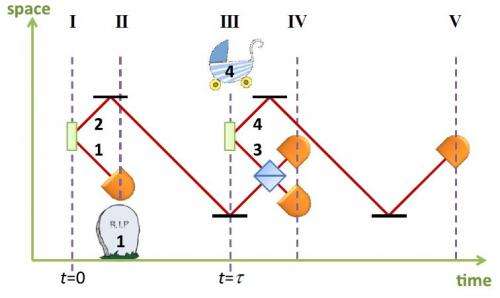May 28, 2013 report
Physics team entangles photons that never coexisted in time

(Phys.org) —Researchers at the Hebrew University of Jerusalem have succeeded in causing entanglement swapping between photons that never coexisted in time. In their paper published in the journal Physical Review Letters, the team explains how their experiment proves true an entanglement phenomenon first described by researchers last year at the University of Erlangen-Nuremberg.
The idea seems not just counterintuitive, but impossible—that photons could be entangled that never existed at the same time—but that's just what the team in Germany, led by Joachim von Zanthier, suggested. In this new effort, the team in Israel, led by Hagai Eisenberg, has proven it's possible by actually doing it.
Entanglement is, of course, where the quantum states of two particles are linked—what happens to one happens to the other regardless of the distance between them. This new work shows that they can be linked via time as well.
To prove it, the researchers first used a laser to cause entanglement between a pair of photons, P1, P2. They then measured the polarization of P1, which was immediately followed by the entangling of another pair of photons, P3, P4. This was followed by measuring P2 and P3 simultaneously and causing them to become entangled with one another—a process known as projective measurement. Then, P4 was measured. Measuring P1 caused its demise of course—before P4 was born—but the measurement of P4 showed that it had become entangled with P1 nevertheless, if only for a very short period of time.
The researchers suggest that the outcome of their experiment shows that entanglement is not a truly physical property, at least not in a tangible sense. To say that two photons are entangled, they write, doesn't mean they have to exist at the same time. It shows that quantum events don't always have a parallel in the observable world.
Being able to entangle particles that don't exist at the same time opens up the door to new encryption techniques for building ultra-secure networks—communications could occur between physical locations, for example, that never actually sent an encrypted key directly to one another. It could also perhaps lead to new developments by researchers hoping to create a true quantum computer.
More information: Entanglement Swapping between Photons that have Never Coexisted, Phys. Rev. Lett. 110, 210403 (2013) DOI: 10.1103/PhysRevLett.110.210403
Abstract
The role of the timing and order of quantum measurements is not just a fundamental question of quantum mechanics, but also a puzzling one. Any part of a quantum system that has finished evolving can be measured immediately or saved for later, without affecting the final results, regardless of the continued evolution of the rest of the system. In addition, the nonlocality of quantum mechanics, as manifested by entanglement, does not apply only to particles with spacelike separation, but also to particles with timelike separation. In order to demonstrate these principles, we generated and fully characterized an entangled pair of photons that have never coexisted. Using entanglement swapping between two temporally separated photon pairs, we entangle one photon from the first pair with another photon from the second pair. The first photon was detected even before the other was created. The observed two-photon state demonstrates that entanglement can be shared between timelike separated quantum systems.
Journal information: Physical Review Letters
© 2013 Phys.org

















